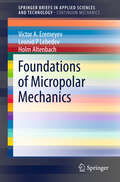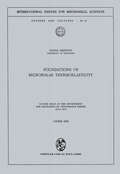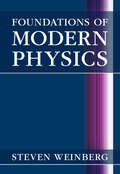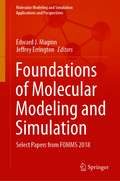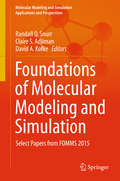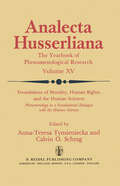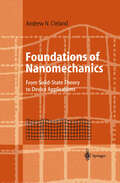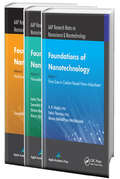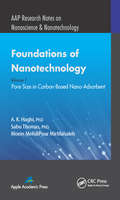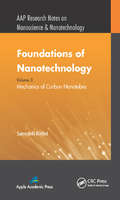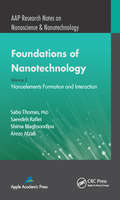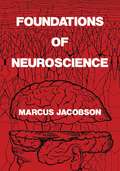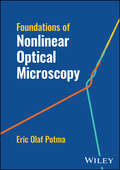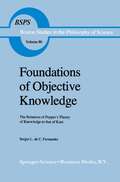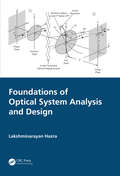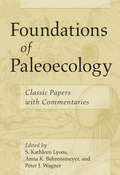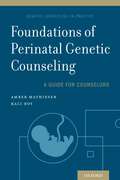- Table View
- List View
Foundations of Micropolar Mechanics (SpringerBriefs in Applied Sciences and Technology)
by Victor A. Eremeyev Leonid P. Lebedev Holm AltenbachThe book presents foundations of the micropolar continuum mechanics including a short but comprehensive introduction of stress and strain measures, derivation of motion equations and discussion of the difference between Cosserat and classical (Cauchy) continua, and the discussion of more specific problems related to the constitutive modeling, i.e. constitutive inequalities, symmetry groups, acceleration waves, etc.
Foundations of Micropolar Thermoelasticity: Course held at the Department for Mechanics of Deformable Bodies July 1970 (CISM International Centre for Mechanical Sciences #23)
by Cemal EringenFoundations of Molecular Modeling and Simulation: Select Papers from FOMMS 2018 (Molecular Modeling and Simulation)
by Edward J. Maginn Jeffrey ErringtonThis highly informative and carefully presented book comprises select proceedings of Foundation for Molecular Modelling and Simulation (FOMMS 2018). The contents are written by invited speakers centered on the theme Innovation for Complex Systems. It showcases new developments and applications of computational quantum chemistry, statistical mechanics, molecular simulation and theory, and continuum and engineering process simulation. This volume will serve as a useful reference to researchers, academicians and practitioners alike.
Foundations of Molecular Modeling and Simulation: Select Papers from FOMMS 2015 (Molecular Modeling and Simulation)
by Randall Q. Snurr Claire S. Adjiman David A. KofkeThis book is a collection of select proceedings of the FOMMS 2015 conference. FOMMS 2015 was the sixth triennial FOMMS conference showcasing applications of theory of computational quantum chemistry, molecular science, and engineering simulation. The theme of the 2015 meeting was on Molecular Modeling and the Materials Genome. This volume comprises chapters on many distinct applications of molecular modeling techniques. The content will be useful to researchers and students alike.
Foundations of Morality, Human Rights, and the Human Sciences: Phenomenology in a Foundational Dialogue with the Human Sciences (Analecta Husserliana #15)
by Calvin O. Schrag Anna-TeresaTymienieckaThe essays in this volume constitute a portion of the research program being carried out by the International Society for Phenomenology and the Human Sciences. Established as an affiliate society of the World Institute for Ad vanced Phenomenological Research and Learning in 1976, in Arezzo, Italy, by the president of the Institute, Dr Anna-Teresa Tymieniecka, this particular society is devoted to an exploration of the relevance of phenomenological methods and insights for an understanding of the origins and goals of the specialised human sciences. The essays printed in the first part of the book were originally presented at the Second Congress of this society held at Purdue University, West Lafayette, Indiana, 12-14 July 1979. The second part of the volume consists of selected essays from the third convention (the Eleventh International Congress of Phenomenology of the World Phenomen ology Institute) held in Cambridge, Massachusetts in 1981. With the third part of this book we pass into the "Human Rights" issue as treated by the World Phenomenology Institute at the Interamerican Philosophy Congress held in Tallahassee, Florida, also in 1981. The volume opens with a mono graph by Anna-Teresa Tymieniecka on the foundations of ethics in the moral practice within the life-world and the social world shown as clearly distinct. The main ideas of this work had been presented by Tymieniecka as lead lectures to the three conferences giving them a tight research-project con sistency.
Foundations of Nanomechanics: From Solid-State Theory to Device Applications (Advanced Texts in Physics)
by Andrew N. ClelandThis text provides an introduction, at the level of an advanced student in engineering or physics, to the field of nanomechanics and nanomechanical devices. It provides a unified discussion of solid mechanics, transducer applications, and sources of noise and nonlinearity in such devices. Demonstrated applications of these devices, as well as an introduction to fabrication techniques, are also discussed. The text concludes with an overview of future technologies, including the potential use of carbon nanotubes and other molecular assemblies.
Foundations of Nanotechnology - Three Volume Set
by A. K. Haghi Sabu Thomas Moein MehdiPour MirMahaleh Saeedeh Rafiei Shima Maghsoodlou Arezo AfzaliNanoscale science, engineering, and technology-commonly referred to collectively as nanotechnology-is believed by many to offer extraordinary economic and societal benefits. Nanotechnology is generally defined as the ability to create and use materials, devices, and systems with unique properties at the scale of approximately 1 to 100 nm. Nanotechn
Foundations of Nanotechnology, Volume One: Pore Size in Carbon-Based Nano-Adsorbents
by A. K. Haghi Sabu Thomas Moein MehdiPour MirMahalehThis volume covers a wide range of adsorption activities of porous carbon (PC), CNTs, and carbon nano structures that have been employed so far for the removal of various pollutants from water, wastewater, and organic compounds. The low cost, high efficiency, simplicity, and ease in the upscaling of adsorption processes using PC make the adsorption
Foundations of Nanotechnology, Volume Three: Mechanics of Carbon Nanotubes
by Saeedeh RafieiIn this research notes book, the modelling of mechanical properties of CNT/polymer nanocomposites is presented. The book begins with the structural and intrinsic mechanical properties of CNTs and then introduces computational methods that have been applied to polymer nanocomposites, covering from molecular scale (molecular dynamics, Monte Carlo), m
Foundations of Nanotechnology, Volume Two: Nanoelements Formation and Interaction
by Sabu Thomas Saeedeh Rafiei Shima Maghsoodlou Arezo AfzaliThe collection of topics in this book reflects the diversity of recent advances in nanoelements formation and interactions in nanosystems with a broad perspective that is useful for scientists as well as for graduate students and engineers. One of the main tasks in making nanocomposites is building the dependence of the structure and shape of the n
Foundations of Neuroscience
by Marcus JacobsonThe author makes a unique contribution to the field by discussing the history and philosophy of the neurosciences, and then developing critical approaches which integrate techniques, theory, and ethics. Taken as a whole, Jacobson's work will provide a coherent and humane framework for future research programs. The paperback edition of this highly successful text, first published in 1993, is now available! The author brings the ethics of neuroscience into a closer relationship with empirical research. Covering the field's history, philosophy, theories, and techniques, this volume provides the necessary moral and ethical framework to evaluate neuroscience research.
Foundations of Nonlinear Optical Microscopy
by Eric Olaf PotmaFoundations of Nonlinear Optical Microscopy Concise yet comprehensive resource presenting the foundations of nonlinear optical microscopy Foundations of Nonlinear Optical Microscopy brings together all relevant principles of nonlinear optical (NLO) microscopy, presenting NLO microscopy within a consistent framework to allow for the origin of the signals and the interrelation between different NLO techniques to be understood. The text provides rigorous yet practical derivations, which amount to expressions that can be directly related to measured values of resolution, sensitivity, and imaging contrast. The book also addresses typical questions students ask, and answers them with clear explanations and examples. Readers of this book will develop a solid physical understanding of NLO microscopy, appreciate the advantages and limitations of each technique, and recognize the exciting possibilities that lie ahead. Foundations of Nonlinear Optical Microscopy covers sample topics such as: Light propagation, focusing of light, pulses of light, classical description of light-matter interactions, and quantum mechanical description of light-matter interactionsMolecular transitions, selection rules, signal radiation, and detection of lightMulti-photon fluorescence and pump-probe microscopyHarmonic generation, sum-frequency generation, and coherent Raman scattering Senior undergraduate and graduate students in chemistry, physics, and biomedical engineering, along with students of electrical engineering and instructors in both of these fields, can use the information within Foundations of Nonlinear Optical Microscopy and the included learning resources to gain a concise yet comprehensive overview of the subject.
Foundations of Nonlinear Optical Microscopy
by Eric Olaf PotmaFoundations of Nonlinear Optical Microscopy Concise yet comprehensive resource presenting the foundations of nonlinear optical microscopy Foundations of Nonlinear Optical Microscopy brings together all relevant principles of nonlinear optical (NLO) microscopy, presenting NLO microscopy within a consistent framework to allow for the origin of the signals and the interrelation between different NLO techniques to be understood. The text provides rigorous yet practical derivations, which amount to expressions that can be directly related to measured values of resolution, sensitivity, and imaging contrast. The book also addresses typical questions students ask, and answers them with clear explanations and examples. Readers of this book will develop a solid physical understanding of NLO microscopy, appreciate the advantages and limitations of each technique, and recognize the exciting possibilities that lie ahead. Foundations of Nonlinear Optical Microscopy covers sample topics such as: Light propagation, focusing of light, pulses of light, classical description of light-matter interactions, and quantum mechanical description of light-matter interactionsMolecular transitions, selection rules, signal radiation, and detection of lightMulti-photon fluorescence and pump-probe microscopyHarmonic generation, sum-frequency generation, and coherent Raman scattering Senior undergraduate and graduate students in chemistry, physics, and biomedical engineering, along with students of electrical engineering and instructors in both of these fields, can use the information within Foundations of Nonlinear Optical Microscopy and the included learning resources to gain a concise yet comprehensive overview of the subject.
Foundations of Objective Knowledge: The Relations of Popper’s Theory of Knowledge to that of Kant (Boston Studies in the Philosophy and History of Science #86)
by Sergio L. FernandesKant and Popper. The affmity between the philosophy of Kant and the philosophy of Karl Popper has often been noted, and most decisively in Popper's own reflections on his thought. But in this work before us, Sergio Fernandes has given a cogent, comprehensive, and challenging investigation of Kant which differs from what we may call Popper's Kant while nevertheless showing Kant as very much a precursor of Popper. The investigation is directly conceptual, although Fernandes has also contributed to a novel historical understanding of Kant in his reinterpretation; the novelty is the genuine result of meticulous study of texts and commentators, characterized by the author's thorough command of the epistemological issues in the philosophy of science in the 20th century as much as by his mastery of the Kantian themes of the 18th. Naturally, we may wish to understand whether Kant is relevant to Popper's philosophy of knowledge, how Popper has understood Kant, and to what extent the Popperian Kant has systematically or historically been of influence on later philosophy of science, as seen by Popper or not.
Foundations of Optical System Analysis and Design
by Lakshminarayan HazraSince the incorporation of scientific approach in tackling problems of optical instrumentation, analysis and design of optical systems constitute a core area of optical engineering. A large number of software with varying level of scope and applicability is currently available to facilitate the task. However, possession of an optical design software, per se, is no guarantee for arriving at correct or optimal solutions. The validity and/or optimality of the solutions depend to a large extent on proper formulation of the problem, which calls for correct application of principles and theories of optical engineering. On a different note, development of proper experimental setups for investigations in the burgeoning field of optics and photonics calls for a good understanding of these principles and theories. With this backdrop in view, this book presents a holistic treatment of topics like paraxial analysis, aberration theory, Hamiltonian optics, ray-optical and wave-optical theories of image formation, Fourier optics, structural design, lens design optimization, global optimization etc. Proper stress is given on exposition of the foundations. The proposed book is designed to provide adequate material for ‘self-learning’ the subject. For practitioners in related fields, this book is a handy reference. Foundations of Optical System Analysis and Synthesis provides A holistic approach to lens system analysis and design with stress on foundations Basic knowledge of ray and wave optics for tackling problems of instrumental optics Proper explanation of approximations made at different stages Sufficient illustrations for facilitation of understanding Techniques for reducing the role of heuristics and empiricism in optical/lens design A sourcebook on chronological development of related topics across the globe This book is composed as a reference book for graduate students, researchers, faculty, scientists and technologists in R & D centres and industry, in pursuance of their understanding of related topics and concepts during problem solving in the broad areas of optical, electro-optical and photonic system analysis and design.
Foundations of Optical System Analysis and Design
by Lakshminarayan HazraSince the incorporation of scientific approach in tackling problems of optical instrumentation, analysis and design of optical systems constitute a core area of optical engineering. A large number of software with varying level of scope and applicability is currently available to facilitate the task. However, possession of an optical design software, per se, is no guarantee for arriving at correct or optimal solutions. The validity and/or optimality of the solutions depend to a large extent on proper formulation of the problem, which calls for correct application of principles and theories of optical engineering. On a different note, development of proper experimental setups for investigations in the burgeoning field of optics and photonics calls for a good understanding of these principles and theories. With this backdrop in view, this book presents a holistic treatment of topics like paraxial analysis, aberration theory, Hamiltonian optics, ray-optical and wave-optical theories of image formation, Fourier optics, structural design, lens design optimization, global optimization etc. Proper stress is given on exposition of the foundations. The proposed book is designed to provide adequate material for ‘self-learning’ the subject. For practitioners in related fields, this book is a handy reference. Foundations of Optical System Analysis and Synthesis provides A holistic approach to lens system analysis and design with stress on foundations Basic knowledge of ray and wave optics for tackling problems of instrumental optics Proper explanation of approximations made at different stages Sufficient illustrations for facilitation of understanding Techniques for reducing the role of heuristics and empiricism in optical/lens design A sourcebook on chronological development of related topics across the globe This book is composed as a reference book for graduate students, researchers, faculty, scientists and technologists in R & D centres and industry, in pursuance of their understanding of related topics and concepts during problem solving in the broad areas of optical, electro-optical and photonic system analysis and design.
Foundations of Organic Chemistry: Unity and Diversity of Structures, Pathways, and Reactions
by David R. DaltonThis book differs from other organic chemistry textbooks in that it is not focused purely on the needs of students studying premed, but rather for all students studying organic chemistry. It directs the reader to question present assumptions rather than to accept what is told, so the second chapter is largely devoted to spectroscopy (rather than finding it much later on as with most current organic chemistry textbooks). Additionally, after an introduction to spectroscopy, thermodynamics and kinetics, the presentation of structural information of compounds and organic families advances from hydrocarbons to alcohols to aldehydes and ketones and, finally, to carboxylic acids.
Foundations of Organic Chemistry: Unity and Diversity of Structures, Pathways, and Reactions
by David R. DaltonThis book differs from other organic chemistry textbooks in that it is not focused purely on the needs of students studying premed, but rather for all students studying organic chemistry. It directs the reader to question present assumptions rather than to accept what is told, so the second chapter is largely devoted to spectroscopy (rather than finding it much later on as with most current organic chemistry textbooks). Additionally, after an introduction to spectroscopy, thermodynamics and kinetics, the presentation of structural information of compounds and organic families advances from hydrocarbons to alcohols to aldehydes and ketones and, finally, to carboxylic acids.
Foundations of Organic Chemistry: Unity and Diversity of Structures, Pathways, and Reactions
by David R. DaltonLearn the fundamentals and foundations of modern organic chemistry with this comprehensive guide Foundations of Organic Chemistry: Unity and Diversity of Structures, Pathways, and Reactions, 2nd Edition, is a substantive guide for students beginning their study of organic chemistry and instructors, as well as senior undergraduates and graduate students seeking to further their understanding of the subject. Foundations of Organic Chemistry is a serious attempt to show students who want to learn organic chemistry how we know what we know about the subject and to guide them to learn. In this work, the emphasis of the discussion of structures, pathways, and reactions is placed on the original literature and the fundamentals and use of spectroscopic and kinetic tools. Application of the resulting working knowledge of the substance of organic chemistry will lead the serious student to ask additional questions and, ultimately, to solve problems we face. The book also includes solutions guides for instructors and lecturers, as well as access to a companion website for furthering the reader’s knowledge of organic chemistry.
Foundations of Organic Chemistry: Unity and Diversity of Structures, Pathways, and Reactions
by David R. DaltonLearn the fundamentals and foundations of modern organic chemistry with this comprehensive guide Foundations of Organic Chemistry: Unity and Diversity of Structures, Pathways, and Reactions, 2nd Edition, is a substantive guide for students beginning their study of organic chemistry and instructors, as well as senior undergraduates and graduate students seeking to further their understanding of the subject. Foundations of Organic Chemistry is a serious attempt to show students who want to learn organic chemistry how we know what we know about the subject and to guide them to learn. In this work, the emphasis of the discussion of structures, pathways, and reactions is placed on the original literature and the fundamentals and use of spectroscopic and kinetic tools. Application of the resulting working knowledge of the substance of organic chemistry will lead the serious student to ask additional questions and, ultimately, to solve problems we face. The book also includes solutions guides for instructors and lecturers, as well as access to a companion website for furthering the reader’s knowledge of organic chemistry.
Foundations of Paleoecology: Classic Papers with Commentaries
by Kathleen Lyons Anna K. Behrensmeyer Peter WagnerApproximately 99% of all life that has ever existed is extinct. Fortunately, these long dead species have left traces of their lives and interactions with other species in the rock record that paleoecologists use to understand how species and ecosystems have changed over time. This record of past life allows us to study the dynamic nature of the Earth and gives context to current and future ecological challenges. This book brings together forty-four classic papers published between 1924 and 1999 that trace the origins and development of paleoecology. The articles cross taxonomic groups, habitat types, geographic areas, and time and have made substantial contributions to our knowledge of the evolution of life. Encompassing the full breadth of paleoecology, the book is divided into six parts: community and ecosystem dynamics, community reconstruction, diversity dynamics, paleoenvironmental reconstruction, species interaction, and taphonomy. Each paper is also introduced by a contemporary expert who gives context and explains its importance to ongoing paleoecological research. A comprehensive introduction to the field, Foundations of Paleoecology will be an essential reference for new students and established paleoecologists alike.
Foundations of Paleoecology: Classic Papers with Commentaries
by Kathleen Lyons Anna K. Behrensmeyer Peter WagnerApproximately 99% of all life that has ever existed is extinct. Fortunately, these long dead species have left traces of their lives and interactions with other species in the rock record that paleoecologists use to understand how species and ecosystems have changed over time. This record of past life allows us to study the dynamic nature of the Earth and gives context to current and future ecological challenges. This book brings together forty-four classic papers published between 1924 and 1999 that trace the origins and development of paleoecology. The articles cross taxonomic groups, habitat types, geographic areas, and time and have made substantial contributions to our knowledge of the evolution of life. Encompassing the full breadth of paleoecology, the book is divided into six parts: community and ecosystem dynamics, community reconstruction, diversity dynamics, paleoenvironmental reconstruction, species interaction, and taphonomy. Each paper is also introduced by a contemporary expert who gives context and explains its importance to ongoing paleoecological research. A comprehensive introduction to the field, Foundations of Paleoecology will be an essential reference for new students and established paleoecologists alike.
Foundations of Paleoecology: Classic Papers with Commentaries
Approximately 99% of all life that has ever existed is extinct. Fortunately, these long dead species have left traces of their lives and interactions with other species in the rock record that paleoecologists use to understand how species and ecosystems have changed over time. This record of past life allows us to study the dynamic nature of the Earth and gives context to current and future ecological challenges. This book brings together forty-four classic papers published between 1924 and 1999 that trace the origins and development of paleoecology. The articles cross taxonomic groups, habitat types, geographic areas, and time and have made substantial contributions to our knowledge of the evolution of life. Encompassing the full breadth of paleoecology, the book is divided into six parts: community and ecosystem dynamics, community reconstruction, diversity dynamics, paleoenvironmental reconstruction, species interaction, and taphonomy. Each paper is also introduced by a contemporary expert who gives context and explains its importance to ongoing paleoecological research. A comprehensive introduction to the field, Foundations of Paleoecology will be an essential reference for new students and established paleoecologists alike.
Foundations of Perinatal Genetic Counseling (Genetic Counseling in Practice)
by Amber Mathiesen Kali RoyAn essential new text for genetic counseling's most sought-after skills Foundations of Perinatal Genetic Counseling is a practical introduction to the concepts and skills in genetic counseling with clients before and during pregnancy. Authored by genetic counselors at the forefront of contemporary perinatal practice, this all-in-one reference provides an accessible yet comprehensive overview of: · the basics of pregnancy, including assisted reproductive technologies and high-risk pregnancy management · preimplantation and prenatal genetic screening and diagnosis · the structure and goals of a genetic counseling appointment · common clinical scenarios and best-practice approaches Distilling the most pertinent information for new learners and practicing counselors, Foundations of Perinatal Genetic Counseling is an essential companion for both classroom and clinic. Perinatal genetic counselors will find themselves returning to this unique resource long after their training has come to an end.
